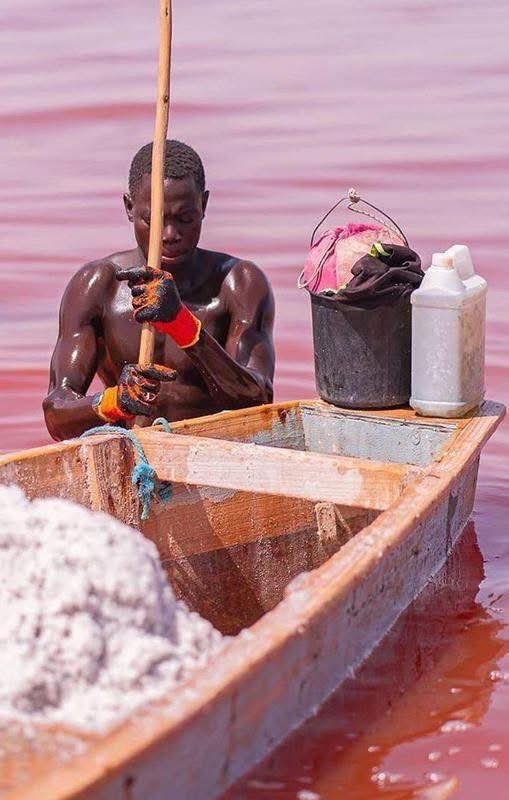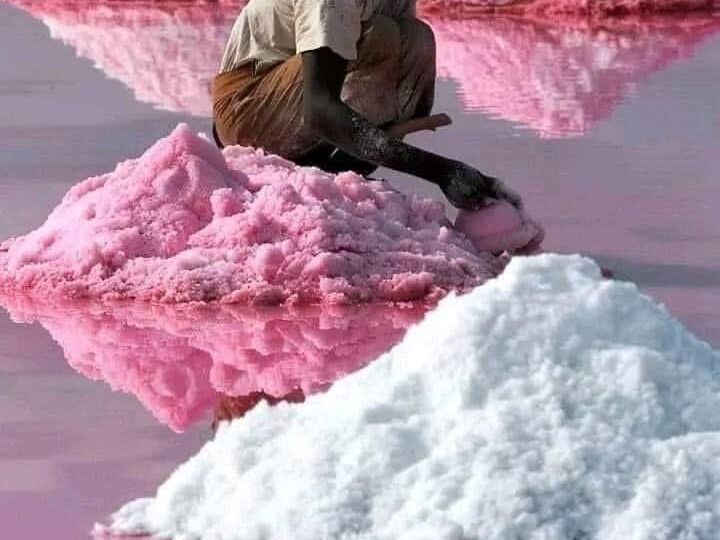When I first stumbled across a photo of Lake Retba on X, I couldn’t believe my eyes. The water was a surreal shade of bubblegum pink, dotted with pyramids of white salt, reflecting the sky like a mirror. A lone worker sat on one of the salt mounds, his silhouette framed against the vibrant backdrop. It looked like something out of a dream—a place where reality bends into the fantastical.
Located just 35 kilometers northeast of Dakar, Lake Retba sits north of the Cap Vert peninsula in northwest Africa, a narrow strip of dunes separating it from the Atlantic Ocean. Spanning about 3 square kilometers, it’s not a massive body of water, but what it lacks in size, it makes up for in sheer wonder.
The lake’s rosy hue, which can deepen to a vivid pink during the dry season, comes from a tiny algae called Dunaliella salina. These microscopic organisms thrive in the lake’s extreme salinity—up to 40% in some areas, saltier than the Dead Sea—and produce a red pigment, beta-carotene, to absorb sunlight and survive the harsh conditions.
It’s nature’s way of painting a masterpiece, and I couldn’t help but feel a sense of awe at how something so small could transform an entire landscape.
As I dug deeper, I learned that Lake Retba isn’t just a visual spectacle; it’s a lifeline for the people who live around it. The images from the X post showed workers in the lake, one crouched on a salt mound, another standing in a wooden boat, scooping salt from the water. These men and women are salt harvesters, and their work is as grueling as the lake is beautiful.

They wade into the hypersaline water for hours, sometimes up to seven hours a day, collecting salt that crystallizes naturally on the surface due to the lake’s high salt content and the scorching sun. The process is labor-intensive: they scrape the salt from the lakebed, pile it into boats, and then haul it to the shore to dry in those iconic pyramid-shaped mounds. Once dried, the salt is crushed, iodized, and packed for sale—some used locally to preserve fish for Senegal’s national dish, thieboudienne (a fish and rice combo), and some exported to nearby countries.
But the work comes at a cost. The lake’s salinity, while a boon for salt production, is brutal on the human body. The water can burn the skin, and prolonged exposure can lead to tissue damage. To protect themselves, harvesters rub their bodies with beurre de Karité—shea butter made from shea nuts—an emollient that acts as a barrier against the harsh salt.
I can only imagine the sting of that water on bare skin, the way it might cling to every crevice, leaving behind a gritty residue. Yet, these workers endure it day after day, their hands calloused, their bodies glistening with sweat and shea butter under the unrelenting sun.
Seydou Touré, a salt harvester quoted in an article from Eater, described the process as “taxing,” but also spoke with pride about the lake’s beauty, encouraging others to visit and witness the labor that goes into every grain of salt. “It’s really a beautiful place to visit,” he said. “We encourage our brothers and sisters from Senegal to come discover it, and to see all the pain the workers endure to harvest the salt.”
Reading that, I felt a pang of admiration mixed with empathy. There’s something deeply humbling about the way these workers transform a natural phenomenon into a livelihood, their lives intertwined with the rhythms of the lake. Around 38,000 to 60,000 metric tons of salt are harvested from Lake Retba each year, a staggering amount that underscores its importance to Senegal’s economy.
And the lake’s salt is abundant—unlike seawater, where you’d need to evaporate vast fields to get a small yield, Lake Retba’s salt crystallizes right on the surface, ready to be collected. In fact, a harvested area can be ready again in just 45 days, a testament to the lake’s unique ecosystem.
But Lake Retba’s beauty isn’t constant, and that’s part of what makes it so fascinating. The pink color peaks during the dry season, from November to June, when the sun is at its strongest and the salinity is highest, creating the perfect conditions for Dunaliella salina to produce its pigments.
During the wet season, from July to October, the lake’s hue can fade, sometimes turning a dark blue-green as rainfall dilutes the salt concentration and clouds block the sunlight the algae need to thrive. In 2022, an especially intense wet season brought torrential rains to the region, leading to devastating floods in Dakar and surrounding areas.
The floodwaters breached the lake’s banks, washing away the salt mounds that harvesters had painstakingly collected. I can only imagine the heartbreak of seeing days or weeks of labor swept away in an instant, the white pyramids dissolving back into the water from which they came.
That event, documented by NASA’s Earth Observatory, was a stark reminder of how fragile this ecosystem can be. Lake Retba is the only pink lake in Africa, but similar phenomena exist elsewhere—Torrevieja Lagoon in Spain and Lonar Lake in India also owe their rosy hues to the same algae.
Yet, there’s something uniquely captivating about Lac Rose, perhaps because of its proximity to the Atlantic, just a kilometer away, where the contrast between the pink lake and the ocean’s deep blue-green feels like a collision of two worlds.
Beyond its natural beauty and economic significance, Lake Retba holds cultural and historical weight. Since 2005, it has been under consideration as a UNESCO World Heritage Site, a status it still held as of 2023. That recognition would bring global attention to the lake, potentially boosting tourism and providing resources to support the local community.
But it would also shine a spotlight on the challenges the harvesters face—challenges that go beyond the physical toll of their work. The lake’s ecosystem is vulnerable to climate change, with shifting weather patterns threatening its delicate balance. More frequent floods, like the one in 2022, could disrupt salt production and the livelihoods that depend on it. And as tourism grows, there’s the risk of overexploitation, a common issue for natural wonders that become too popular too fast.
As I reflect on Lake Retba, I can’t help but think about the duality of its existence. On one hand, it’s a place of breathtaking beauty, a natural wonder that draws people from around the world to marvel at its pink waters and float effortlessly in its salty embrace, much like the Dead Sea.
On the other hand, it’s a place of struggle, where workers toil under harsh conditions to harvest the salt that sustains their families and fuels a vital industry.
If I ever get the chance to visit Lake Retba, I know I’ll be struck by its otherworldly beauty, the way the pink water stretches out like a canvas under the sky. But I’ll also be thinking about the hands that shaped those salt pyramids, the stories of the harvesters who have worked there for generations, and the delicate balance that keeps this lake alive.
It’s a reminder that behind every stunning photograph, there’s a deeper human story waiting to be told—a story of beauty, labor, and the unbreakable bond between people and the land they depend on. Lake Retba isn’t just a pink lake; it’s a testament to the resilience of nature and the people who live in harmony with it, even when the odds are stacked against them.
So, the next time you see a photo of Lac Rose, take a moment to look beyond the pink. Think about the algae that paint the water, the workers who harvest the salt, and the fragile ecosystem that holds it all together. It’s a place that’s as complex as it is beautiful, and it deserves to be seen—and appreciated—for all that it is.

